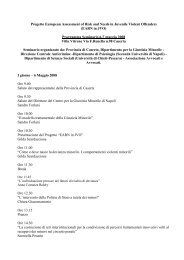Scarica il documento - Dipartimento per la Giustizia Minorile
Scarica il documento - Dipartimento per la Giustizia Minorile
Scarica il documento - Dipartimento per la Giustizia Minorile
Create successful ePaper yourself
Turn your PDF publications into a flip-book with our unique Google optimized e-Paper software.
allegati<br />
Mst therapists are closely su<strong>per</strong>vised and monitored for adherence to the Mst<br />
principles and receive weekly guidance and feedback about their interventions with the<br />
fam<strong>il</strong>ies on their caseloads.<br />
the Mst process begins with the identification of the problem behaviours, a process<br />
that involves the whole fam<strong>il</strong>y. in other words, parents are key in identifying treatment<br />
targets. examples of these behaviours include non-compliance with fam<strong>il</strong>y rules, fa<strong>il</strong>ure<br />
to attend school, fa<strong>il</strong>ure to complete school work, substance use, disrespect to authority<br />
figures, and assaultive behaviour. Wh<strong>il</strong>e the focus is on elimination of problem behaviours,<br />
this is accomplished in great measure by bu<strong>il</strong>ding on strengths. the assessment process also<br />
involves identifying the strengths in the young <strong>per</strong>son and his fam<strong>il</strong>y, which can include a<br />
hobby, athletic ab<strong>il</strong>ity, a trusting re<strong>la</strong>tionship with an extended fam<strong>il</strong>y member or teacher,<br />
warmth and love among fam<strong>il</strong>y members. the next step is an assessment of the factors<br />
in the young <strong>per</strong>son’s ecology, which support the continuation of the problem behaviours<br />
and the factors, which o<strong>per</strong>ate as obstacles to their elimination. these factors may be<br />
found in any sphere of the young <strong>per</strong>son’s ecology: fam<strong>il</strong>y, peers, school, neighbourhood<br />
or the linkages among them. therefore, therapists are called upon to find information<br />
from all of these sources, by going to the school, spending time with the peer group, or<br />
speaking with extended fam<strong>il</strong>y members. examples of these factors might include poor<br />
discipline sk<strong>il</strong>ls on the part of the parents or teachers, marital discord, parental substance<br />
use, poor su<strong>per</strong>vision, peer reinforcement of problem behaviours, neighbourhood culture,<br />
which condones violence or encourages antisocial values, low commitment to education,<br />
chaotic school environment, poor parent-to-school communication, or financial stresses<br />
ex<strong>per</strong>ienced by the fam<strong>il</strong>y.<br />
By identifying the “fit” between the problems and the broader systemic context,<br />
Mst therapists are defining both the targets of intervention and the indicators of whether<br />
the measures undertaken have been effective. a therapeutic strategy should produce<br />
observable results in the problem behaviour or else the strategy is revised. in other words,<br />
positive changes in the behaviour (eg, school attendance) is used as indication that the<br />
intervention (eg, parent contacting the school da<strong>il</strong>y) is on the right track. Fa<strong>il</strong>ure to achieve<br />
positive changes requires a reassessment of the “fit” and p<strong>la</strong>inly indicates the need to try<br />
a new approach. the Mst service providers are ultimately accountable for overcoming<br />
barriers to change. B<strong>la</strong>ming <strong>la</strong>nguage such as “sabotage,” “resistance,” and “intractable<br />
problems” are not <strong>per</strong>mitted. in fact, diagnostic <strong>la</strong>bels of any type are discouraged in<br />
favour of a <strong>per</strong>spective that focuses on challenges and strengths.<br />
Mst is designed to be an intense but short-term involvement, which can result<br />
in the generalisation of treatment gains over the long-term. ideally, the frequency and<br />
duration of contacts w<strong>il</strong>l decrease over time, being intense in the beginning but lessening as<br />
improvements are observed. No social service intervention can <strong>la</strong>st forever, so the ultimate<br />
goal is to empower the fam<strong>il</strong>y or other caregiver to continue with the strategies and<br />
interventions, which were successful. the clearly articu<strong>la</strong>ted definition of success <strong>per</strong>mits<br />
objective definition of when the case can be closed.<br />
several randomised and quasi-ex<strong>per</strong>imental studies of Mst have been conducted in<br />
the usa, in Missouri, south Carolina, and texas, and others are now under way. Mst has<br />
been demonstrated to reduce rates of criminal activity (officially recorded and self-reported)<br />
and institutionalisation. the Mst approach is also successful at engaging and retaining<br />
252





